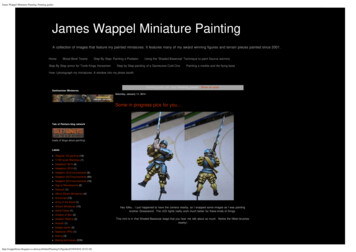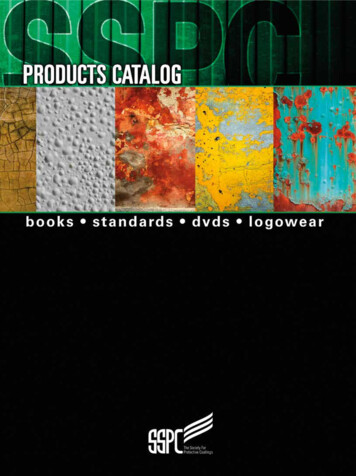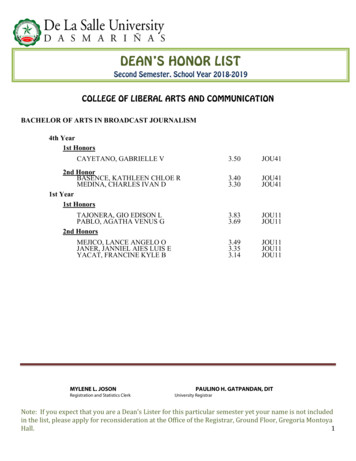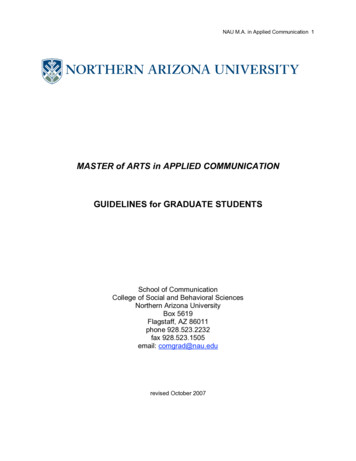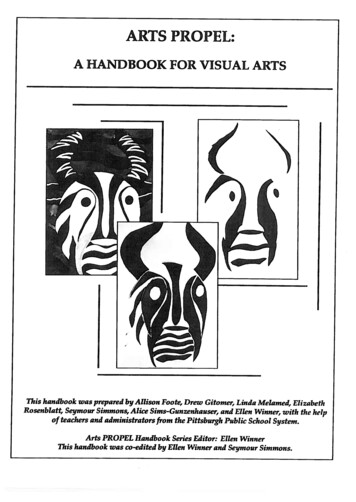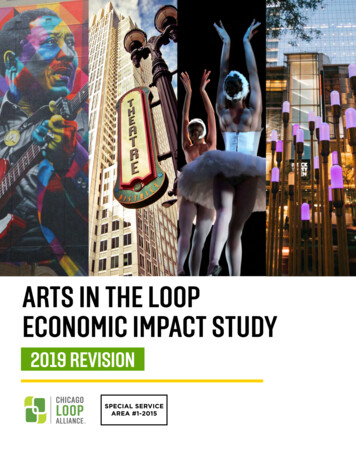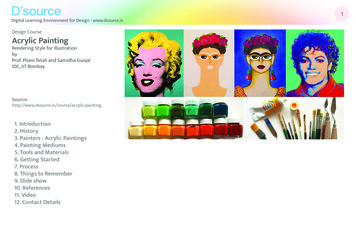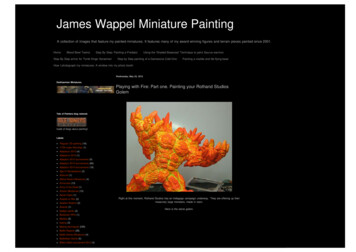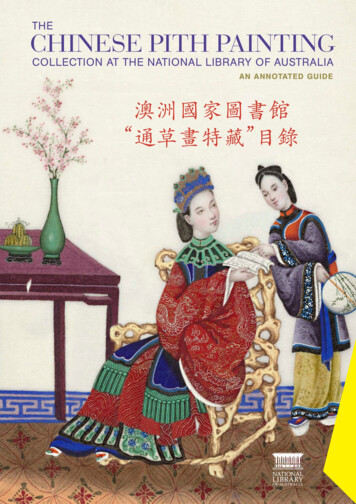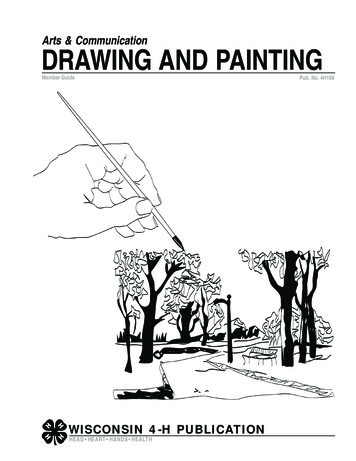
Transcription
Arts & CommunicationDRAWING AND PAINTINGMember GuideWISCONSIN 4-H PUBLICATIONHEAD HEART HANDS HEALTHPub. No. 4H169
ContentsA note to parents.2Introduction.2Ideas about drawing and sketching. 3Contour drawing. 4Portraits of yourself and others.5Gesture or speed drawing.6Drawing human figures.6Figure drawing exercises. 7Dots to create images.11Work problems.11Understanding color.12Exercises in color.13Two-dimensional art.14Watercolor painting.16Becoming acquainted with materials.16Becoming acquainted with watercolors.17Beginning to watercolor.17Increasing your imaginative powers.17Skylines and rooftops in watercolor.18Techniques in watercolor.19Painting with acrylics. 20Selecting acrylic paints.20Brushes. 20Palette.21Easel.21Painting surfaces. 21Painting on solid form surfaces. 21Colors to use. 22Advanced project.22Painting ideas. 22A viewfinder for seeing.22Ideas from imagination.23Starting to paint.15WISCONSIN 4-HPub. No. 4H169, Pg. 1
A note to parentsYou are the most important and influential person in yourchildren’s lives. You can nurture and cultivate their interest inthis project by guiding them in their planning, assisting themin carrying out their project and by recognizing them for a jobwell done.The information in this guide can provide significant learningexperiences for your children. Planning the things they willlearn and do and assessing their progress based on theirplans will help make their experiences more worthwhile. Thisplanning and evaluating individually with your children maybe done by their project leader. However, if this is notpossible, you can fulfill this need.Following are some things you as a parent can do to helpyour children get the most out of this project:y Become familiar with the material in this member guide.yHelp your children select project goals they can likelyachieve. These should be recorded on the MemberPlanning and Evaluation Form (MPE).yHelp them decide what tools, equipment and suppliesthey will need and what they can realistically expect tohave.yHelp them understand and learn how to do the tasks theymust do to carry out their plans. Do no do their work forthem.yAssist them in scheduling their time.yDiscuss their progress with them from time to time.yHelp them recognize a good job from a poor one.yCommend them on things they have done well. (As themost important person in their lives, a pat on the backfrom you is one of the highest rewards they can receive.)yHelp them understand where they need to improve.yHelp them to know themselves, their strengths andweaknesses, and to compete with their own abilities.yHelp them to evaluate what they have done and whatthey have learned on the basis of the goals they have setthemselves. Do not compare their progress with others.Each is unique and needs to be treated individually.IntroductionThis guide is for those young people who have alwayswished they could draw or paint. Let us agree first that youare an artist. Your interest in drawing and painting canbecome an outward expression of the thoughts and feelingsin your mind. The practice of art is to enable you to underWISCONSIN 4-Hstand, to become more aware of the world you live in, and todiscover the joy in creating. Art is an activity every one canparticipate in, at whatever level of ability he or she may have.Everybody has tried to express ideas with a pencil or brush.You may have said to yourself, “I never had any lessons indrawing or painting. I wouldn’t even know where to begin.There must be some way to start.” The first and mostimportant step is to begin drawing and painting for fun.Never mind how awkward or clumsy your first attempts are;they are yours. You made them, and nobody else hadanything else to do with them. Don’t be discouraged bycomparing your drawings or paintings with others.Everyone creates differently. Enjoy the fact you are expressing yourself in your own personal way. By doing that, youare as creative as any artist.Have fun following the suggestions in this guide. They willhelp you learn to describe more clearly on paper or boardthings you have seen or imagined. The aim of the activities isto encourage a sense of discovery and to learn the disciplineof handling drawing and painting materials. Your ability toobserve and to imagine will grow through the fun of drawingand painting.There are three stages in developing you art ability.1. The first stage begins with practice to acquire techniques,to become acquainted with your materials and tools, andto discover an independent attitude toward art.2. The second stage is one of experimenting, in which youmust search to find what you want to express and topractice with intense interest to improve your way ofexpression. As a young child you may not have beenconcerned about how to draw or what to draw. Yousimply drew because it was fun. You had an idea and youproceeded to draw. Develop a similar attitude as youexperiment with ideas.The ideas outlined in this guide are to get you started, togive you some ways to draw or paint, and to have funworking at them. It is not necessary to have a lot ofinstruction, just a few approaches to get you started.Then, draw or paint wherever and whenever you can.Don’t judge your work too soon or be over- critical ofyour efforts. Draw and paint many times in many ways sothat you can compare what you have done and see howyou have improved.3. The third stage comes to those who have drawn orpainted enough to acquire technical control and canfreely communicate what they know in their art.Pub. No. 4H169, Pg. 2
Of these three stages only the first can be taught. You canlearn about procedures in techniques and methods oforganizing your ideas. However, after this, you are on yourown to search around you, to use your imagination, and toexpress yourself.We all have the ability to express ourselves through the arts.We must not be discouraged by the difficulties we meetalong the way. (See Image 1.)Drawing materialsy Soft lead pencils - 2B or 3ByCharcoal pencils - 4B (The numbers stamped on thepencils indicate degree of softness. 4B is softer than 3B.)yNylon and felt-tip pens in black and colored inksyWatercolors with a medium size watercolor boxyFine point steel penyBottle of India inkDrawing surfacesVarious hard finish papers suitable for drawing in pencil,watercolor painting, and ink drawingyyGood quality writing or typing paperyWhite shelf paperyWhite bristol board from an art shopyAll-purpose white drawing and sketching pads in 9" x 12"or 12" x 15" sizesIt is not necessary to sharpen drawing pencils to a fine point.A single-edge razor blade can be used to cut away the wood,exposing about one-half inch of graphite or lead.A fine, delicate line can be made by slightly turning the pencilas you move it across the paper. Only a slight amount ofpressure is needed for thin lines; use heavier pressure forbroad dark lines.Seeing is an act of observing - an intense, concentratedexperience in observing with our eyes. Let’s use an example.Look at the open palm of your hand. See with a consciouseffort the many creases and folds in your hand. With thatbrief but deliberate effort in seeing, you become consciouslyaware of the many details that are present in front of youreyes but that you have not always recognized.This kind of seeing is valuable and important in manyactivities. The hunter in the field must use his eyes forselective seeing where generalized looking would miss manythings. The baseball or the football player needs preciseseeing to throw, catch or hit a ball. Looking is not enough.To realize fully this marvelous experience of seeing, we mustmake a conscious effort at concentrated seeing. In art, seeingis closely associated with the process of creating images andsymbols, based on observing our environment.We communicate to ourselves what we see through adelineating process called drawing.Drawing is a natural experience for all of us. When we werevery young we enjoyed drawing with a pencil or a crayon.Our drawings were freely created from our memory orimagination. Now we realize that our eyes can give us muchmore information about what we see at the moment ofdrawing. It opens a new world of expressing ideas.How important for any kind of an expression is the ability todraw? Artists and craftspeople give form to their ideasthrough a variety of drawing techniques and materials. Allthese are done by marking, scratching, stroking, smudging orrubbing on a surface using a pencil, pen and ink, brush,crayon or chalk. Frequently the artist uses tools other thanImage 1: We communicate to ourselves what we seethrough drawing.Ideas about drawing and sketchingToday we are exposed to many visual images found in books,magazines, photographs, newspapers, television, and theInternet. As a result we are well acquainted with the experience of using our eyes to look but we seldom realize the needto consciously see.Looking is a common experience. It is casual, indefinite anduntrained. It helps us get around safely through doors, walkacross a street, go up stairs, etc. We have little consciousawareness of the miracle of sight and what a gift it is to reallysee.WISCONSIN 4-HPub. No. 4H169, Pg. 3
those associated with drawing - a scriber in enamel powder, astick on the side of a clay pot, or thread in a stitchery.Drawing is a means of recording what we see with greaterclarity. (See Image 2.) This information and detail helps usorganize our ideas for painting in oil, watercolor or acrylics.Above all, drawing can be enjoyed as a creative experience indefining vague ideas from our imagination or memory intovisual statements. We can alter, modify, revise and changethese ideas as they come forth until we are pleased with theresults.Contour drawingThis is an exploration with a method of drawing that stressesthe coordination of hand and eye. The objective is to haveour eyes observe and carefully follow the edge or contour ofan object and at the same time draw a corresponding line witha pencil, recording this eye path.With a soft drawing pencil and white drawing paper 9" x 12"or 12" x 18", try a series of contour drawings. The first objectto draw will be your hand. Place your left hand in an interesting relaxed position. It can rest on the paper, holding it inplace on the table.Focus your eye on some point or place on the object (anypoint will do) along the contour of the object. Contour isconsidered to be the outermost edge of the object as you seeit. Imagine that the tip of your pencil is touching the objectinstead of the paper. Without taking your eye off the model,proceed to draw a continuous line corresponding to the samekind of contour your eye is following.Remember to consciously move your eyes along the contour.At the same time draw a line on paper which records your eyepath. Avoid looking at the drawing paper and concentrateintently on the “seeing” experience. This activity is verysimilar to the method of practicing at the piano or thetypewriter. In these examples the eye concentrates on readingthe notes or words and permits the hands or fingers tocontact the keys by touch.At times you will find that the contour you see will leadinside the object area. When this happens, glance down atthe paper to determine a new starting point. Locate this newstarting point with your pencil and determine from that pointwhere the contour turned inwards.You may glance down at the paper several times during thedrawing experience but do not draw while you are looking atthe paper.There will be other contours lying within the outer edges ofthe object. Draw these in the same manner as the outercontour edges. Make yourself think that your eye is actuallytouching the object.This experiment should be done slowly, searchingly andsensitively. Take time; don’t be impatient or quick. A contourstudy does not have to be finished because it is a selectedseeing experience, to be continued as long as you have thepatience.You may indeed find it difficult to break a long habit oflooking at the paper as you draw. Resist and make it a game.Contour drawing is different from outline drawing. You“think” of the contact with the object as going into theshadow or coming out in the light by varying the pressure onthe pencil. This will give a thick or thin line.Your beginning drawings may
04.10.2015 · Drawing is a means of recording what we see with greater clarity. (See Image 2.) This information and detail helps us organize our ideas for painting in oil, watercolor or acrylics. Above all, drawing can be enjoyed as a creative experience in defining vague ideas from our imagination or memory into visual statements. We can alter, modify, revise and change these ideas as they come forth until .
